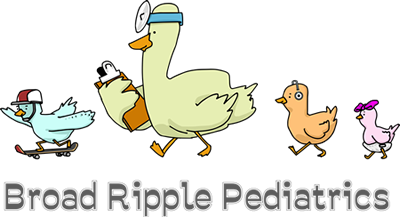Temperature-taking recommended with digital thermometers:
Fever defined as:
rectal temperature greater than 100.4 degrees F (38 degrees C)
oral temperature greater than 99.5 degrees F
axillary (armpit) greater than 99 degrees F
Please note that the following are guidelines only. Your child’s general appearance and the way he is acting are usually more important indicators of illness than the height of the fever. You should always call if your child looks or acts significantly ill for any period of time or if you are concerned about worsening health.
Call immediately if:
- Your child looks or acts very ill for any period of time.
- You think your child has had a seizure.
- Your child is less than 3 months old and has a temperature of 100.5 degrees F or higher.
- Your child is over 3 months and less than 3 years old, and the fever is over 102 degrees F and he or she is not acting well.
- Your child is over 3 years old, feverish, and does not look well, and does not perk up significantly after an appropriate dose of fever medicine.
- Your child is crying inconsolably.
- Your child cries if you touch him or move him.
- Your child is difficult to awaken.
- Your child complains of a stiff neck and cannot touch the chin to the chest without pain.
- Purple spots are present on the skin and these do not blanch (whiten) when pressed firmly.
- Breathing is labored and no better after the nasal passages are cleared.
- Your child is unable to swallow anything and is drooling saliva.
- Your baby’s fontanelle (“soft spot”) is bulging when he or she is sitting up quietly.
- There is redness or swelling around the eye or pain with eye movements.
- There is redness, tenderness, or swelling over an arm or leg.
- Your child walks with a limp or refuses to move a leg joint.
- Your child has a compromised immune system (e.g., the spleen has been removed, the child is undergoing chemotherapy, or is HIV positive) or sickle cell anemia.
- You have any other concerns about the fever that make you feel immediate care is necessary.
Call within 24 hours if:
- Your child suffers from a burning sensation or pain during urination.
- Your child complains of ear pain.
- Your child complains of a sore throat and any of the following: swollen glands, headache, abdominal pain, rash, or joint pain.
- Your child voids dark urine 3 or 4 weeks after a sore throat.
- Your child’s fever lasts more than 48 hours without any obvious cause or infection.
Call during regular office hours if:
- Your child’s fever is greater than 101.5 degrees F for more than 72 hours.
- The fever has been normal for 24 hours and then returned.
- Your child has a history of seizures with fever and you wish to review fever management.
- You have other concerns or questions regarding fever.
Dosage Charts
*ACETAMINOPHEN DOSAGE CHART*
(Doses may be administered every 4 hours not to exceed 5 doses in 24 hours)
|
Age |
Weight |
Elixir 160 mg/ tsp |
Chewable Tabs 160 mg/tab |
|
0-3 months |
6-11 lbs. |
1/4 tsp. |
|
|
4-11 months |
12-17 lbs. |
1/2 tsp. |
|
|
12-23 months |
18-23 lbs. |
3/4 tsp. |
|
|
2-3 years |
24-35 lbs. |
1 tsp. |
1 tab |
|
4-5 years |
36-47 lbs. |
1 1/2 tsp. |
1 1/2 tabs |
|
6-8 years |
48-59 lbs |
2 tsp. |
2 tabs |
|
9-10 years |
60-71 lbs. |
2 1/2 tsp. |
2 1/2 tabs |
|
11 years |
72-95 lbs |
3 tsp. |
3 tabs |
|
12-14 years |
96 lbs & over |
see adult dosage |
see adult dosage |
*IBUPROFEN CHART
(Ibuprofen may be given every 4 to 6 hours for fever above 102 degrees F.)
|
Age |
Weight |
Oral Suspension 100 mg/5 ml |
Chewable Tablets 100 mg/tab |
|
6-11 months |
12-17 lbs. |
2.5 ml |
|
|
12-23 months |
18-23 lbs. |
3.75 ml |
|
|
2-3 years |
24-35 lbs. |
5 ml |
1 tablet |
|
4-5 years |
36-47 lbs. |
7.5 ml |
1.5 tablets |
|
6-8 years |
48-59 lbs. |
10 ml |
2 tablets |
|
9-10 years |
60-71 lbs. |
12.5 ml |
2.5 tablets |
|
11 years |
62-95 lbs. |
15 ml |
3 tablets |
|
12 years & older |
> 95 lbs. |
See adult dosage |
See adult dosage |
|
|
|
|
